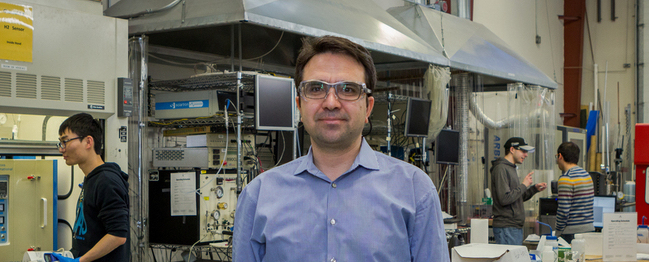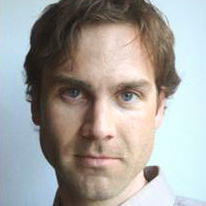Via UConn Today:
Dr. Michael Pettes and his graduate student Wei Wu have significantly improved the performance of an atomically thin semiconductor material by stretching it, an accomplishment that could prove beneficial to engineers designing the next generation of flexible electronics, nano devices, and optical sensors. The findings mark the first time scientists have been able to conclusively show that the properties of atomically thin materials can be mechanically manipulated to enhance their performance, Pettes says. Such capabilities could lead to faster computer processors and more efficient sensors. The process the researchers used to achieve the outcome is also significant in that it offers a reliable new methodology for measuring the impact of strain on ultrathin materials, something that has been difficult to do and a hindrance to innovation. More information is available at UConn Today: http://s.uconn.edu/4ad
Two ME professors received the 2018 National Science Foundation’s CAREER award, which is the Foundation’s most prestigious award in support of early-career faculty.
Prof. Xu Chen’s award will support his research on thermal modeling, sensing, and controls to enable new generations of powder bed fusion (PBF) additive manufacturing. In contrast to conventional machining, where parts are made by cutting away unwanted material, additive manufacturing — also called 3D printing — builds three-dimensional objects of unprecedented complexity by progressively adding small amounts of material. PBF is a popular form of AM for fabricating complex metallic or high-performance polymer parts. This CAREER project will create new knowledge critical for substantially higher accuracy and greater reproducibility in PBF and AM. Building on innovations to model and control the thermal mechanical process, the research will illuminate ways to mitigate quality variations on the fly, and provide new feedback-centric control paradigms to engineer the layered deposition of thermal energy, which is imperative for quality and reproducibility. PBF parts are increasingly preferred in applications ranging from advanced jet-engine components to custom-designed medical implants. The outcomes of this project will facilitate fabrication of products to benefit the US economy and improve quality of life. More broadly, methods and tools developed from this research has the potential to drastically impact the manufacturing of a wide range of components for the energy, aerospace, automotive, healthcare, and biomedical industries that can benefit from short-run high-quality production.
Prof. Norato’s award will support fundamental research to formulate a design framework to systematically incorporate geometric design rules and manufacturing cost considerations into the computational design of structures. In particular, the techniques advanced in this project belong to a group of techniques called topology optimization, in which a computer program finds the optimal shape of a structural component or an architected material. This research will enable the conceptual design and optimization of lightweight, high-performance, and economically-viable structures with applications across a wide range of engineering industries. The new design capabilities will have the potential to significantly reduce manufacturing and R&D costs and thereby increase the economic competitiveness of American manufacturers. Prof. Norato is also a recipient of the 2017 ONR Young Investigator Award.
Both awards are for five years and approximately $500,000 (minimum), and have an outreach component towards K-12 students and people from underrepresented communities.

The new grant funded by the US Department of Energy supports new graduate programs in Mechanical Engineering to train the next generation of advanced manufacturing leaders. The UConn effort has been led by Prof. Ugur Pasaogullari.
More details can be found on the School of Engineering website.
More details about the research being developed in Prof. Thanh Nguyen’s research group can be found in UConn Today.
Dr. Xinyu Zhao has been awarded an American Chemical Society Grant through the Petroleum Research fund for her research entitled “A computational study of the lean blow-off mechanisms for a bluff-body stabilized premixed flame.” The fund supports research directly related to petroleum and fossil fuels at nonprofit institutions around the world.

Increasingly stringent emission requirements have recently generated a great deal of interest in lean and stable combustors, i.e. combustors that manipulate air-fuel ratios to increase fuel efficiency and reduce emissions while maintaining stable combustion. One way to stabilize flames in a combustor is through bluff bodies, but the events that lead to lean blowoff (flame extinction) remain unclear due to a variety of factors that require consideration (e.g. highly-transient turbulent flow fields and finite-rate chemistry).

Professor Zhao’s research aims to further the understanding of this phenomenon by using a large-eddy simulation to model and investigate a bluff-body stabilized lean premixed propane flame undergoing intense turbulence. UConn ME colleagues in Professor Baki Cetegen’s group carry out the experiments using laser diagnostics. The proposed modeling study allows flame characteristics such as turbulent flame speed, flame surface densities, strain rates, and various chemical and flow time scales relevant to blowoff to be studied and compared with real world experiments. Discovering the key time scales that lead to blowoff could yield controlling strategies and operation conditions for bluff-body stabilized flames.
Recently Professor Zhao also received the Young Investigator (YIP) Award from the Air Force Office of Science and Research. Read more about her research on her website.
The Air Force Office of Scientific Research (AFOSR) Young Investigator Research Program (YIP) has honored Professor Xinyu Zhao as one of just 43 scientists and engineers awarded YIP grants for her research project titled “Pockets in Highly Turbulent Premixed Flames: Physics and Implications on Modeling.” The grant is worth a total of $450,000 over three years and is intended to foster the research of young investigators in science and engineering.
Dr. Zhao’s research aims to understand the underlying physical processes of highly turbulent premixed flames, which impact the efficiency and stability of modern aeronautical engines.

The investigation targets two specific “pockets”: the fresh-mixture pockets on the product side of the flame (“FiP”) and the product pockets on the fresh mixture side of the flame (“PiF”). The existence of these pockets is a distinctive feature of flames within the broken reaction zones, and is hypothesized to contribute to the deviation of the flame statistics from those within the flamelet regimes.

Aiding the current understanding of combustion in aeronautical engines could have far reaching impacts on a number of fields and industries and would be of great benefit to the Air Force. A better understanding of the factors that affect combustion can eventually allow engineers to improve the efficiency of these engines. You can read more about Professor Zhao’s research on her laboratory’s website.
 Assistant Professor David Pierce will be deploying his Interdisciplinary Mechanics Laboratory to tackle three projects that just received funding: two from the National Science Foundation (NSF) and one from the U.S. Army Natick Soldier Research Development and Engineering Center (NSRDEC).
Assistant Professor David Pierce will be deploying his Interdisciplinary Mechanics Laboratory to tackle three projects that just received funding: two from the National Science Foundation (NSF) and one from the U.S. Army Natick Soldier Research Development and Engineering Center (NSRDEC).
The first NSF-funded project (titled Biomechanical Simulations of Progressing Osteoarthritis to Advance Understanding and Therapies) explores how stress distributions within human cartilage tissue affect the progression of osteoarthritis (OA). As Principle Investigator (PI), Prof. Pierce will collaborate with Co-PI Prof. Cory Neu (CU Boulder). Their team will use mechanical and imaging experiments, simulations of virtual evolving in vivo human cartilage, and longitudinal Magnetic Resonance Images (MRIs) from the NIH-funded Osteoarthritis Initiative (OAI) database to characterize how intra-tissue stress distributions relate to progressing OA.
The second NSF-funded project (titled Understanding the Multiscale Mechanics of Nerve Endings to Address Visceral Pain) investigates the biomechanics of colorectal tissue and the micromechanical environment of the tissue’s sensory nerve endings. As Co-PI, Prof. Pierce will collaborate with the project’s PI, fellow UConn Professor Bin Feng. In colorectal tissue, mechanical stretch (distention) results in visceral pain, the signal for which arises in the peripheral nervous system (PNS). Most drug treatments of visceral pain affect both peripheral and central nervous systems (CNS) and result in adverse side effects on the CNS. Advanced understanding of the biomechanics of visceral nerves could lead to more specific and effective therapeutic targets.

Finally, as PI for the NSRDEC-funded project (titled Developing Biofidelic Models as Surrogates for Human Subjects in Protective Clothing and Individual Equipment and Augmentation Testing) Prof. Pierce and his group, in collaboration with NSRDEC, aim to create subject-specific multiscale models of knee joints and cartilage to predict performance of Soldiers carrying various loads. The products of this research will clarify how Soldier-specific loads translate to soft tissues in the joint and how cyclic fatigue under body-borne loads impacts joint health to optimize physical performance and reduce the risk of injury.
For more information about Prof. Pierce’s research, see his Interdisciplinary Mechanics Laboratory website.
The latest issue of Science features a new technology invented and developed by our very own assistant professor Dr. Thanh D. Nguyen. Prof. Nguyen’s brainchild, developed during his postdoc with Prof. Robert Langer at MIT, offers the latest advance in 3D manufacturing for microstructures of biomaterials: StampEd Assembly of polymer Layers, or SEAL for short. The reliance of current 3D printing techniques on potentially toxic impurities (e.g. UV-curing agents) for formulating printable inks poses clear problems for bio and medical applications. SEAL, on the other hand, can create nearly any 3D micro-objects of pure biopolymers (e.g. polymers used for surgical sutures) with complex geometries and at high resolution. Such enhanced biocompatibility of fabricated 3D microstructures for medical applications enables a broad scope of exciting new possibilities. For example, Prof. Nguyen along with other researchers at MIT used SEAL to create 3D core-shell micro-particles containing biological cargos (e.g. vaccines), which can be programed to sequentially release at different times or even at specific locations within the body. The compelling implications of this technique include the potential for a new set of single-injection vaccines/drugs, which could avoid the repetitive, painful, expensive, and inconvenient injections often required to administer vaccines and drug therapies like insulin or growth hormone. To view the article, click here.